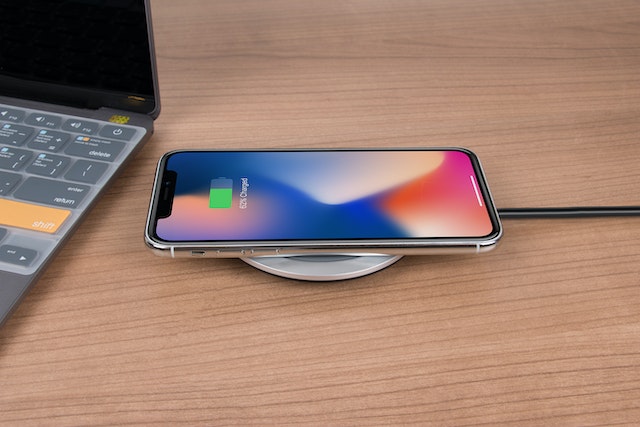
How does wireless charging work? By sending power from a transmitter to a receiver.
Wireless charging is known as inductive charging and it is very common these days. Many of us charge our phones by placing them on a magnetic wireless charging pad. But, how does wireless charging work?
It uses something called inductive charging. The charging pad has a coil of copper wire in it. Copper is usually used because it has a very low resistance, which makes it an excellent conductor if electricity. A current is passed through the copper wire and this produces a magnetic field. The electric current used is an alternating current which causes the strength of the magnetic field to pulse.
The thing being charged, a phone in most cases these days, also has a coil of copper wire in it, which is the receiver. When it is placed close enough to the charging pad, the alternating magnetic field pushes or pulls the electrons around the atoms in the receiver and creates an electric current. This current is then fed into the battery.
When you are charging a phone, it is pretty small and it is easy to place it close to the transmitter. Some devices, such as electric cars, can’t be placed that close to the transmitter. The magnetic field decreases with distance, so it gets harder to charge an object that is removed from the charger. The strength of the magnetic field can be increased if a higher current is delivered, but this becomes impractical. It can also be increased if larger coils are used, but this is also impractical after a certain size. One way to increase the power transfer is to use magnetic resonance. With a magnetic resonance charger, both of the coils are resonated at a specific frequency. If the resonating frequencies are exactly the same, the energy from the transmitter is attracted directly to the receiver, without spreading out into the air. This system will work over a distance of tens of centimeters and more power is transferred more efficiently than with inductive charging.
Wireless charging is a very convenient way of charging devices, but it is not as efficient as using a cable. The problem doesn’t come from the electricity. The problem comes from the alignment. When you charge using any method, some of the power is lost as heat. This is unavoidable and it is why your phone and the cable get warm when you charge them. When you use a wireless charger, the receiver and the transmitter need to be exactly in alignment. If they are out by even a few millimeters, it will take longer to charge the phone and require more energy, which costs more. This can be as much as 50% more than charging with a cable. An experiment showed that a wired Pixel 4 used 14.26 Watt-hours (Wh) when charging from 0 to 100%. On a wireless charging stand it used 19.8, which is 39% more. When the phone and the charging pad were misaligned, it used 25.62 Wh. That is enough power to light an LED light for about 2.5 hours. It doesn’t sound like a lot, but if we remember that there are billions of smartphones in the world, it adds up pretty quickly. Also, wireless charging pads are always on, which means they are constantly using electricity. It isn’t a lot, but it is worth considering.
Induction power transfer has been around for over a hundred and fifty years. Michael Faraday was the first person to discover that a magnetic field could induce a current. Nikola Tesla demonstrated magnetic resonance coupling at the end of the 19th century. In 1894 by M. Hutin and M. Le-Blanc. They had an idea for a way to charge an electric vehicle. Electric vehicles were far more common than gasoline vehicles at the turn of the century. It was only the discovery of large quantities of oil that pushed the balance the other way and their wireless charger fell by the wayside.
Wireless charging was picked up again in the 70s and has improved to the point where it is today. The technology will continue to improve and it will become more efficient and work over greater distances. Roads could be lined with charging materials so that electric vehicles constantly charge as they move. However, batteries need to improve in sync with this technology. Batteries that are made of silicon and charge in as little as five minutes are already being developed. And this is what I learned today.
Sources
https://en.wikipedia.org/wiki/Inductive_charging
https://en.wikipedia.org/wiki/Inductive_coupling
https://case-mate.com/blogs/case-mate-blog/how-does-wireless-charging-work
https://www.nde-ed.org/Physics/Magnetism/electricitymagnet2.xhtml
https://patents.google.com/patent/US527857A/en
https://debugger.medium.com/wireless-charging-is-a-disaster-waiting-to-happen-48afdde70ed9
https://www.digikey.com/en/articles/inductive-versus-resonant-wireless-charging
